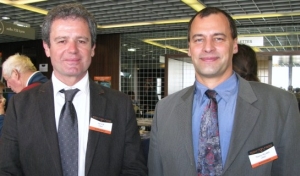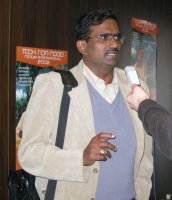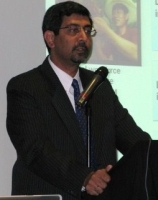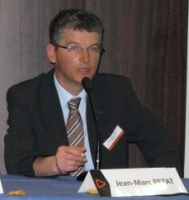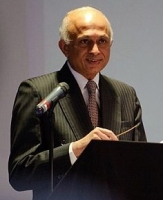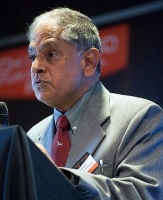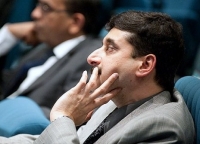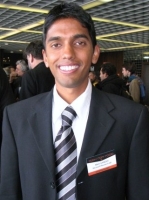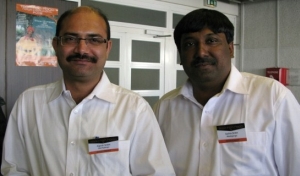
Tech For Food 2009 report
The third Tech For Food forum (TFF) took place on Wednesday 25 February in the Paris International Agricultural show bringing together close to one hundred persons from various backgrounds but all sharing the same firm belief : information and communication technologies (ICT) can be placed at the service of agricultural development and food security in the developing countries. This year TFF proposed to participants to focus on the Indian experience in the field of ICTs. Several projects were presented by speakers from the agricultural revolution country : eSagu, Village Knowledge Centres, Village Resource Centres, e-Choupal, Digital Green, Akashganga, Nokia Life Tools. European projects were also presented : e-agriculture, SIST and Educ’Phyto.
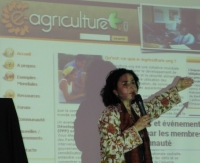
- Sophie Treinen
The day started with the presentation of the e-agriculture.org platform by Sophie Treinen from the FAO. Launched in September 2007 by the FAO, e-agriculture.org is an internet platform whose mission is to serve as a meeting and exchange point between persons interested in using ICTs to develop agriculture. At present it groups over 4,300 members from various backgrounds. Mrs Treinen restated the interest of having French language partners to enhance the content and exchanges in French on the platform.
Joël Sor and Thierry Helmer took turns to present the SIST platform (Technical and Scientific Information System),
launched by the CIRAD four years ago and already implemented in nine African countries. One of the main goals of SIST is to serve as a display-case for national and regional scientific activity in Africa on the Web. The structuring model of the SIST in each country gives priority to the autonomy of the system, requesting an active participation from local stake-holders as soon as it is implemented. Senegal and Madagascar are the countries where SIST developed best up to now. Mssrs. Sor and Helmer are now reflecting on the conditions to have the local populations and farmers benefit from the system.
Coming from the International Institute of Information Technology (IIIT) in Hyderabad, Professor Krishna Reddy outlined e-Sagu, a system of customized agricultural technical consulting based on the use of information technologies, in particular, digital cameras, CDs, the internet and mobile phones. Consult the article previously published on the FARM site for a detailed description of the system. In his address Professor Reddy stressed the importance of "coordinators" to the success of the system. These mediators are trained in the use of ICTs and are used as a liaison between farmers and agronomical experts : on the one hand to inform the experts about the problems facing farmers and on the other to pass on and explain the technical advice provided by the experts to the farmers. Professor Reddy also specified that in the last stage of the pilot e-Sagu project, mobile phones were included in the system’s information chain : coordinators can now receive agricultural advice by SMS. Professor Reddy now intends to deploy eSagu on a larger scale.
Jawahar Kanjilal, head of services to emerging markets at Nokia, presented Nokia Life Tools, a new range of services in the fields of agriculture, education and entertainment. As regards agriculture, Nokia Life Tools proposes integrating customized information needed by farmers into the structure of Nokia cell phone devices. When first used, the farmer answers a series of questions into the cell phone to inform the system as to his specific information needs (geographic location, type of crops, etc.). The system can then send to the farmer information relevant for his activity. The information is presented across an appropriate and simple interface. Nokia Life Tools will be in the pilot phase in India during 2009.
Jean-Marc Petat, head of Government Affairs for BASF France, presented the BASF educational software called Educ’Phyto, the goal of which is to facilitate training in good practices in using phytosanitary products. Launched in France in 2008, Educ’Phyto is built on a playful model offering users the possibility of hunting down the risks of using phytosanitary products through images and animations. In addition to innovating in its approach to technical agricultural training, Educ’Phyto is available on CD and the internet and the total duration of the training is only 15 minutes. Mr. Petat spoke of BASF’s intention to adapt Educ’Phyto to various agricultural realities in developing countries, in particular in Africa. Along these lines, Bernard Bachelier, director of the FARM foundation, addressed the issue of collaboration between FARM and BASF in the framework of food-production projects and the advantage of proposing Educ’Phyto to African professional organizations concerned.
Following on the address from the Indian ambassador to Paris his Excellency Mr. Ranjan Mathai, who mainly spoke of the progress in India in terms of agricultural development, including the use of ICTs, Professor P.C. Kesavan from the Swaminathan Foundation performed the keynote address for the day. Professor Kesavan set out the Swaminathan Foundation’s approach in using ICTs for rural and agricultural development in India. The central project in this approach concerns the information centres called Village Knowledge Centres (VKC), offering access to a
whole range of information to the inhabitants of rural areas. The main ingredients in this project seem to be the integrated approach to meet the information needs of the rural population (economic, technical agricultural and non agricultural, administrative, practical and health information...) and the importance given to the "ownership" of the centres by the users (with the involvement of the population right from the start, in terms of content but also in financial terms). All the TFF participants greatly appreciated the grounds the foundation’s activities were built on, deeply anchored in the principle of inclusion.
There then followed two presentations from the ISRO, the Indian Space Agency. In the first one, K. R. Manjunath, from the ISRO Space Applications Centre in Ahmedabad, spoke of the role of remote detection for agricultural development and food security in India. In particular he presented the agricultural applications of the Indian Earth Observation System, among them we can mention : the inventory of farm crops, the assessment of the environmental impact of agricultural activities, the drafting of erosion maps all over the country, tracking crop rotations, assessing irrigation efficiency, the inventory of surface waters, assessing the risks of drought, floods, cyclones and of course weather forecasts.
In the second presentation from ISRO, Mrs Radhika Ramachandran, attaché and space adviser to the Indian embassy in Paris, spoke of the Village Resource Centres, a project developed in partnership with the Swaminathan Foundation and integrating the VKC activity presented by Professor Kesavan earlier in the day. Mrs Ramachandran explained how the infrastructure offered by ISRO and managed in line with the model of the Swaminathan Foundation enables communication via satellite between several players in the rural world and institutions generating information. The activities developed in these centres range from remote education to remote medicine and taking in interactive agricultural consultancy systems. India already has 460 of these centres and the government is determined to deploy this model in regions where the system is not yet available so as to have the entire rural population in the country benefit.
V. Sreenivasan, director of European operations for ITC Infotech, presented e-Choupal, a project created in 2000 by ITC with the aim of making Indian farmers more competitive. The network already has over 6,400 information centres in India, enabling some 4 million farmers to sell their farm produce, order pesticides and keep track of prices and markets over the internet. This initiative, like the launch of Nokia Life Tools, shows that the private sector is not standing outside of ICT application projects for agricultural development in India.
Rikin Gandhi, from Microsoft Research India, presented a good agricultural practices sharing project via participating videos. This project is called Digital Green. In a clear and enthusiastic presentation, Mr. Gandhi explained how Microsoft Research had come to the conclusion that, for rural training projects, one of the key success factors was the trust of farmers. There is nothing more legitimate in this domain than messages from farmers themselves wishing to share their know-how with their peers. Microsoft Research also addressed the issue of illiteracy by opting to use video. Small films, eight to ten minutes each, are shot in the fields to record good local agricultural practices and mainly using local farmers as actors. After selection by the Rikin Gandhi team, the films are presented in several villages, two to three evenings per week. The projections of the films are accompanied by explanations and discussions moderated by a mediator. Digital Green has already over 400 films in its video library and Mr. Gandhi is now talking about moving on to a new phase in the project extending it to other regions of India and even other countries.
The last presentation of the day was given over to Akashganga, a project that uses information technologies to facilitate the collection of milk in India. Shah Alpesh Chandrakant, financial director, and Shah Sachin Navnitlal, ICT director of Akashganga, presented the automated milk weighing system, the system to perform quality testing and assessing the rate of fatty matter enabling immediate payment to producers. The system is present in close to 1,500 villages in India and concerns millions of producers.
For further information on Tech For Food : TFF 2009
















